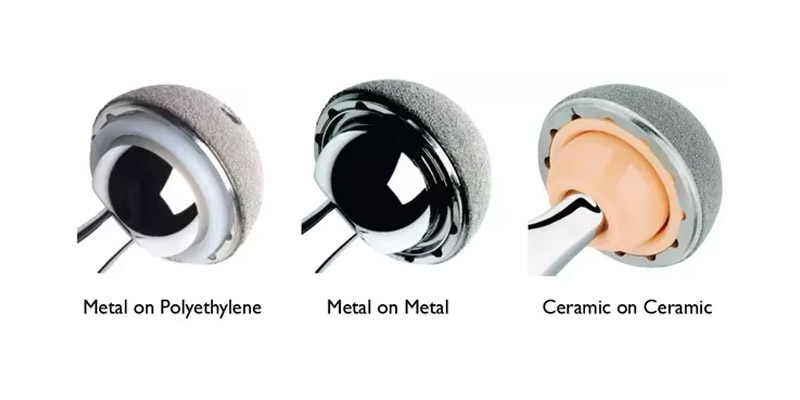
Which Materials Are Used For Hip Replacement Implants?
11 OctThere are a number of hip implant devices available in the market produced by different manufactures, constructed in different model types. The materials used are also varied, but the most popularly used materials include metal and plastic. Metals like titanium and cobalt-chromium alloys are mostly used as they both are inert and don’t interact with the body. However, surgeons avoid using cobalt-chromium alloys for patients with allergy to Nickel. Now speaking of plastic, the most commonly used material is the ultra-high molecular weight polyethylene, which mimics the way a real knee moves. After metal and plastic, ceramic is the third option seen to be used in hip replacement implants.
These materials are used in combinations, and are most commonly seen to fall into one of these three basic categories – Metal on Metal (MoM), Metal on Plastic (MoP), and Ceramic on Ceramic (CoC)/Ceramic on Plastic (CoP). There is no record in the orthopedic industry as to a particular one being the best material type or combination. With multiple options available, the choice mainly depends upon two things – the patient and the surgeon. Every individual surgeon has his particular preference, and innumerous reasons for that choice, including his personal experience, and the tool and implantation method preferences. Similarly, every patient has a particular weight, anatomy, age group, and anatomy level; analyzing which the surgeon comes down to the best choice for the patient.
Metal on Metal (MoM)
This combination is the oldest one seen to have been used since the mid 1950s. These types wear off less quickly than other combinations, which is why they are most preferred. In this combination, both the ball and socket are made of titanium, chromium, cobalt, stainless steel, or a combination of these. A minimally invasive model of the MoM is also available that is smaller in size and can be installed with a smaller incision; meaning less blood flow, lesser pain, and faster recovery.
Metal on Plastic (MoP)
This combination has been in use since the 1960s, and has proven to be very durable and least expensive ever since. In this combination, the hips have metal structural pieces and a plastic liner where the ball and socket meet. Another option is to have a metal ball and a plastic socket liner. As mentioned above, polyethylene is the most popularly used plastic here; but there is a newer version available now known as cross-linked polyethylene, which is more durable.
Ceramic on Ceramic (CoC)/Ceramic on Plastic (CoP)
These combinations have been seen to be used since the 1980s, and became more popular only in the 1990s. These are the most durable options, and a great choice for young patients, or those who lead a hyperactive lifestyle. Ceramic hips are made of a more durable and specialized version of the ceramic that utensils are made of. However, they are also vulnerable to fracture and breaking, while under huge stress. But today, more and more durable ceramic parts are being manufactured that are outdoing metal; so, you need not worry about them being fragile anymore. But yes, one major drawback of these combinations that involve ceramic is that they may squeak a little on movement; however, this sound seems to go away with time.
Decisions, decisions, and more decisions! Obviously, undergoing a total hip replacement in Bangalore is no joke; and you need to make the right choice in every aspect. So, you must research your options, and work with your surgeon to know which the best material is that must be used for your hip implants.

